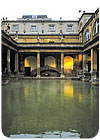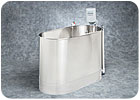2006 Healthcare Plumbing & Piping
Institutional Hydrotherapy And Hot Water - A Delicate Mix

Long employed as water treatment for healing purposes, hydrotherapy - the use of water in the treatment of disease - has been around since ancient times. The Egyptian, Greek, Roman, Hindu and Chinese cultures favored hydrotherapy for centuries, and its value is recognized today.
The process of hydrotherapy is based upon water's absorptive and conductive properties. The effects of hydrotherapy result from its ability to use the human body's response to warm and cold temperatures to assist in the healing process.
The thermal effects of warm water on the skin can result in:
- increased fabrication of stress hormones;
- improved circulation and digestion;
- stimulation of blood flow; and
- limited reaction to pain.

Immersing the body in a bath or whirlpool can give the body a feeling of buoyancy, a relief from gravity, while relieving muscle tension and enhancing circulation.
The various types of bathing hydrotherapy in the modern institutional setting include:
- individual showers;
- full-body immersion baths;
- sitz baths;
- arm/leg baths, hip/extremity baths;
- foot/extremity baths; and
- contrast baths (alternating warm for 1-2 minutes, and cold for 30 seconds, partial immersion).
Spray (douche) hydrotherapy involves the use of a hose to softly spray the skin on various areas of the body, i.e., knee, thigh, lower trunk, arm, chest, upper trunk, back, neck and face.

- Cold water.
- Tepid water (85 to 95 degrees F).
- Neutral temperatures (92 to 95 degrees F).
- Warm temperatures (100 to 106 degrees F).
The upper temperature limits for each category are the maximum temperatures that must be used. These temperature limits should never be exceeded. Please note that the temperatures shown are approximate; a medical professional specifies the water temperature for any hydrotherapy or spray treatment.
There are clear risks associated with hydrotherapy, which include the following:

Excessive Hot Water Temperatures
Such temperatures can cause scalding, most especially for those with a limited ability to sense temperature. Bathing or spray temperatures must be closely monitored at all times, with special attention paid to the young and elderly populations.Extended Immersion Baths
This approach should not be used on those with diabetes, multiple sclerosis, pregnant women, or those with blood pressure issues of any type. The very young and elderly should avoid extended immersion, and bathing times must be precisely monitored for these groups.The correct application of water temperature control devices is critical for providing controlled mixed water temperatures for each type of shower, bath or spray used for hydrotherapy in the institutional environment. The hot water supply temperature in the institution must be controlled at the source, before any of the suggested hydrotherapy mixing devices are installed with the hydrotherapy showers, sprays or baths.

Individual Showers
Individual Showers When using individual showers for hydrotherapy, pressure-balancing shower valves with a built-in temperature gauge are frequently installed. Either pressure-balancing or thermostatic mixing valves are required by code. These valves will maintain temperature despite supply pressure changes. The color-coded thermometer allows institutional personnel and the user to easily monitor the temperature of the shower.
Individual Showers With Spray
For individual spray (douche) hydrotherapy applications of the types listed in this article, a pressure-balancing valve or thermostatic mixing valve, with built-in, color-coded thermometer, is often employed with a hand shower to spray areas of the body.
Full-Body Immersion Baths
As the application becomes more critical in patient care, thermostatic water mixing valves are employed. Full-body immersion tanks (formerly known as Hubbard Tanks) require large volumes of water at a controlled temperature. In this application, large, properly sized thermostatic mixing valve assemblies are installed. These units include the mixing valve, an on/off valve, temperature gauge and vacuum breaker in a prefabricated assembly, often in a chrome finish when exposed. The size of the tank will determine the correct mixing valve assembly for the application.
Sitz Baths
Sitz baths, used to treat the delicate, perineal area of the body, require precise control and monitoring of water temperature. An individual (1/2-inch) concealed thermostatic water mixing valve with indicating thermometer is employed for special tubs used as sitz baths, while an exposed (1/2-inch) thermostatic mixing valve assembly with outlet on/off valve, dial thermometer and vacuum breaker can be used where piping is exposed and a hose is used in the delivery of mixed water for sitz bath applications. The latest edition of the plumbing code now requires thermostatic mixing valves.
Arm/Leg Baths, Hip/ Extremity Baths, Foot/Extremity Baths
Arm, leg, hip, extremity and foot hydrotherapy bathing units require an exposed thermostatic mixing valve assembly in either 1/2- or 3/4-inch size, depending upon the capacity of the unit. These bathing units are offered in several sizes depending upon the treatment for which the system is intended. The chrome-plated valve assembly includes an on/off valve, as well as a vacuum breaker, as the fill point of the tub is often below the water level. As many bathing units include a temperature gauge, the mixing valve assembly often is not furnished with a similar gauge. An optional washout hose is often specified as part of the valve assembly.
- The application for which the bathing equipment is intended. Consult the manufacturer's engineering and application information.
- The size and capacity of the hydrotherapy equipment.
- The type of water mixing valve or assembly required by the bathing unit.
- The size and flow capacity of the water mixing device. Always consult the manufacturer's engineering and application data.

-
1. Follow the valve manufacturer's instructions regarding regular maintenance of the device.
2. Test the mixing valve's high temperature limit stop upon installation and on an ongoing basis in conjunction with the scheduled maintenance for the unit.
3. Verify the accuracy of any temperature gauges - whether installed on the bathing unit or with the mixing device - used in the hydrotherapy process as part of the maintenance process.
From the beginning of time, water has been used to heal, to hydrate and to sustain life. As we have used technology to control its thermal effects with increasing effectiveness, we can take comfort in knowing our ancestors had the right idea about water, our most precious resource.
Looking for a reprint of this article?
From high-res PDFs to custom plaques, order your copy today!




